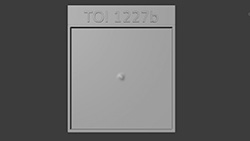CXC Home | Search | Help | Image Use Policy | Latest Images | Privacy | Accessibility | Glossary | Q&A
1
Illustration and X-ray Image of TOI 1227 / TOI 1227 bCredit: X-ray: NASA/CXC/RIT/A. Varga et al.; Illustration: NASA/CXC/SAO/M. Weiss; Image Processing: NASA/CXC/SAO/N. Wolk
An artist’s illustration depicts a Jupiter-sized planet to the lower left closely orbiting a faint red star. New data from Chandra shows that powerful X-rays from the star’s surface are tearing away the atmosphere of the planet represented by the blue tail. Astronomers used X-ray data from Chandra (separate image) to measure the amounts of X-rays from TOI 1227 that are striking the planet. They estimate that the planet is losing a mass equivalent to a full Earth’s atmosphere about every 200 years, causing it to ultimately shrink from the size of Jupiter down to a small, barren world.
2
3D Printable Files: TOI 1227 b(3D Print Credit: NASA/CXC/A. Jubett, using software by Tactile Universe/N. Bonne & C. Krawczyk & Blender)
This tactile plate is a physical relief map based on the intensity of Chandra X-ray data, featuring a small bump, which represents a dim star, closely orbited by a Jupiter-sized planet. Astronomers used the Chandra data to measure the amount of X-rays striking the planet from the star. They estimate that the planet is losing a mass equivalent to a full Earth’s atmosphere about every 200 years, causing it to ultimately shrink from the size of Jupiter down to a small, barren world.
Return to: NASA's Chandra Finds Baby Exoplanet is Shrinking (July 16, 2025)







